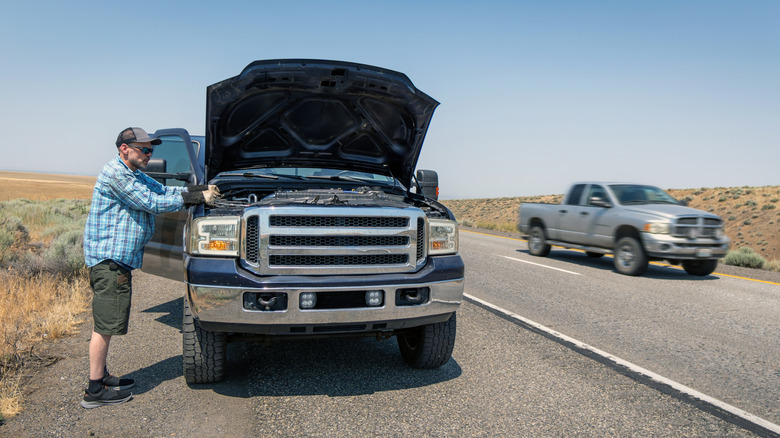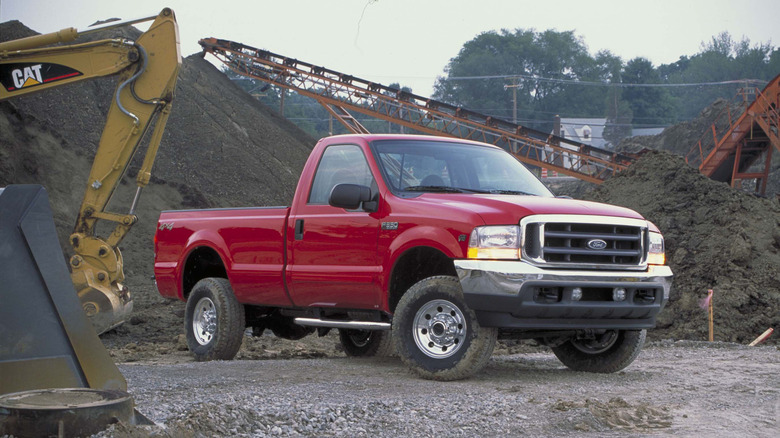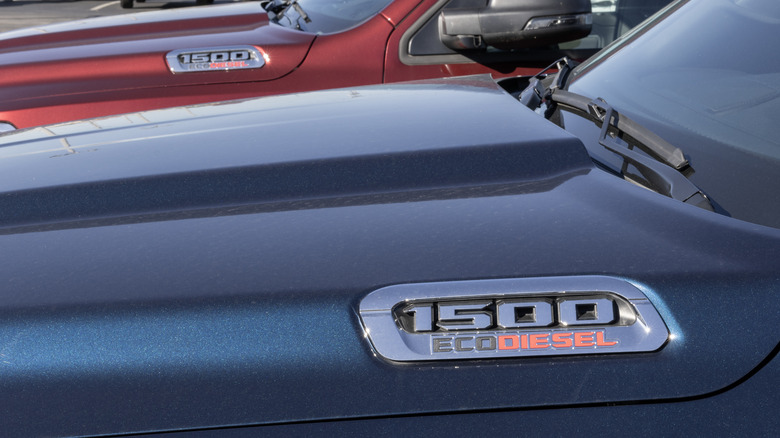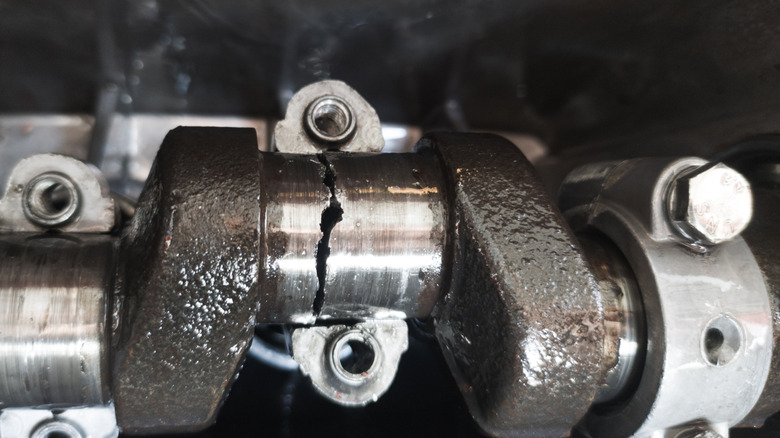5 Of The Worst Diesel Engines Ever Put In A Pickup Truck, According To Owners
While diesel engines have their benefits — fuel economy, towing capacity, torque, and a reputation for ruggedness and longevity — they aren't without their faults. The worst diesel engines can be so unreliable, underpowered, and problematic that they can have their owners wishing they had stuck with gas. Older diesel power plants, in particular, have a reputation for producing plenty of smoke and noise, along with a litany of engine troubles. Smoky diesel exhausts have been rectified in newer models via emissions abatement technology — but many owners are finding that the newer technology comes with its own shortcomings.
Some owners of newer pickups claim the emissions tech is causing problems up to and including catastrophic engine failure, with forums overflowing with tales of owners who "delete" their engine to overcome EPA constraints and "bulletproof" it to eliminate factory flaws. "Deleting," in this context, means removing the emission controls, while "bulletproofing" means rectifying an engine's known faults.
However, extensive bulletproofing can cost more than the engine itself, while a diesel engine delete can be a bad idea for a number of reasons. Apart from landing the owner in legal trouble, a badly executed delete can also cause engine problems. Of course, none of these problems would arise if defective diesel engines were not put into trucks in the first place. By way of warning, these are some of the worst diesel dogs, according to their regretful owners.
GM LF9 5.7L 'Oldsmobile 350'
The GM 5.7L LF9 diesel is a legendary engine for all the wrong reasons. Some owners firmly believe the Olds 350 single-handedly destroyed the U.S. market for diesel engines — and yes, it was that bad. One of the worst American diesel engines ever built, the LF9 started life in 1977, sharing many similarities with GM's V8 gas engines, including 10 cylinder head bolts per side.
Posting on El Camino Central, retired diesel tech trainer Sleepy78 lists "weaknesses across the board," including head bolts insufficient in both number and strength, no means of separating water from fuel, poor oil and fuel filtering, carbon build-up causing rocker and pivot wear, plugged radiators, overheating, crankcase blow-by, oil leaks, and starter motor issues. Sleepy said they picked up Olds 350s virtually free in the 1990s and early 2000s "as no one wanted to be associated with these popcorn machines." Over on The Truck Stop forum, another owner recounts buying a 1981 C10 pickup with 80,000 miles and already on the second engine, which died at 125,000 — not before guzzling a quart of oil every 50 miles.
On the Diesel subreddit, BadBadBenBernanke describes the 350 as "a forgettable engine that powered some forgettable cars," while Proof-Surprise-964 says it had "the acceleration of a sail boat." SimilarTranslator264 says his family owned two 350s, with only one making it to 100,000 miles. "Not only were they loud and didn't like cold weather but they also didn't make much power and didn't last long either."
Ford 6.0L Powerstroke
Introduced in 2003 and fitted to Ford Super Duty trucks until 2007, the 6.0L Powerstroke diesel engine came with a litany of problems, some caused by the car maker's bungled attempts at cleaning up emissions through exhaust gas recirculation (EGR). This led to EGR valves coked with soot, EGR cooler failures, power loss, and — ironically — smoky exhausts.
Not all of the Powerstroke's issues can be blamed on emissions tech, however. The owner of a 2006 F350 recounts how he replaced a high-pressure oil pump, turbo, starter relay, and rear seal — all in under 58,000 miles. Writing on a Powerstroke forum, Fiveton from Dallas said the 6.0 was the worst diesel Ford could have put in a truck. "It now needs a fuel pump and injectors, EGR cooler, degas tank and cap — and my head gaskets are blown." Sadly, Fiveton's story is not uncommon, with another user on the same forum saying their 2005 truck blew an EGR cooler, head gaskets, and turbo, with cracked heads at 35,000 miles.
One owner on the forum argues there are permanent fixes for the six-liter Ford engine's factory shortcomings, but 6.0 Powerstroke owner Duke GSP says their rig was still going to the shop every other month, even after nearly $10,000 was spent under the hood. "I don't think I should have to pay 50k for a truck to turn around and spend thousands more to keep it on the road," Duke GSP writes.
Ram 1500 3.0L EcoDiesel
Spun bearings, blown motors, stalled engines — it's a wonder the 3.0L V6 EcoDiesel stayed in production as long as it did. Introduced by Fiat Chrysler Automobiles in 2014, the three-liter EcoDiesel powered Ram 1500 trucks until 2023. Reports on its reliability vary wildly, with some Ram EcoDiesel model years worse than others. Sadly, the debut year set a precedent by being one of the worst, with one owner forking out more than $14,500 on repairs after their 2014 Ram pickup engine seized after only 57,000 miles.
Other Ram 1500 owners share similar tales on the EcoDieselRam forum, with RiceRocket27 getting just over 100,000 miles before their engine blew, with spun main bearings and a ruined crankshaft. Owners complain of the engine's notoriously narrow main bearings and thin crank webs, which fail to deal with the engine's impressive 420 ft-lb of torque. After losing their engine at 66,000 miles, debbiemike said they traded their vehicle in after being told there were 800 EcoDiesel engines on backorder, while autox recounts their engine blew at 30,000 miles, theorizing "the failed motors are caused by chronically clogged DPF."
EcoDiesel engines stopping suddenly and unpredictably is a recurring theme amongst owners, as is the exorbitant cost of replacement. After one 2020 Ram EcoDiesel owner's truck stopped dead on a highway, it was towed to a Dodge dealership. "They informed me that the engine was gone and I'd need a new engine," Bryan1969 writes on the EcoDieselRam forum. "The cost of the new engine was $30k installed."
Cummins 5.0L V8 Turbo Diesel
Cummins has built some of America's best diesel engines, but the 5.0L V8 isn't one of them. Featuring on our list of the worst ever Cummins engines, this turbocharged diesel first dropped in the Nissan Titan XD in 2016, leaving a trail of frustrated buyers in its wake. Many 2016 models suffered turbocharger failures so catastrophic they required total engine replacements, an issue so prevalent the NHTSA recalled a staggering 12,000 pickups. Nissan axed the ill-fated engine in 2019, but not before owners complained of EGR valve and cooler failures, blown head gaskets, fuel system malfunctions, faulty diesel exhaust fluid (DEF) systems, and more.
On the Titan Talk forum, owners share tales of DEF woe, with Leckster stuck 700 km (435 miles) from the nearest dealer with a "visit dealership" DEF code threatening limp mode after just 300 km. Meanwhile, CumminsForum user krmott50 tells of spending three months and $2500 replacing the seals and EGR assembly in an attempt to fix coolant loss in their 2018 Titan. "3000 miles later it's doing it again," they write.
On the same forum, jason.gokey laments being quoted $35,000 by Nissan to replace a blown 2017 Titan engine, writing, "When the dealership removed the pan, it was full of bearing material and the crankshaft is in 2 pieces." Over on the Titan XD forum, wilsonfence05 says their 2016 XD met a similar fate after the engine lost power and died at 70 mph, with the mechanic finding metal shavings in the oil pan and a fractured crankshaft.
GM 6.5L Detroit Diesel
An engine that powers Humvees for the U.S. military is among the worst diesel engines ever put in a pickup truck? Really? Yes, really. First launched in 1992, and used in Chevrolet C/K 1500, 2500, and 3500 pickups, this Detroit Diesel has a patchy record of reliability. While some model years for the GM 6.5L turbocharged V8 engine are better than others, complaints about the engine's lack of power are almost universal. Add to that overheating issues, with engines made after 1994 habitually melting the plastic case on the electronic injector pump driver, leading to failure.
Owners also face the prospect of cracked engine blocks from poor casting, and crankshafts breaking after the harmonic balancer comes apart. In 2001, GM dumped the Detroit Diesel engine in favor of the Isuzu-built Duramax, which most owners favored for its higher power output. Negative remarks about the 6.5L engine shared on the Diesel subreddit include "obsolete," "absolutely trash," and "so slow," with K-rimes adding, "Mine had 3.73 gears and could barely haul 4000lb without slowing down to a crawl going up grades."
Owner nickaluch says the 6.5L engine is a pain to start on a cold morning, while Dizbeshawn told redditors, "mine overheated on the way out of Phoenix just towing 2 wave runners up a 5% grade" before cracking both heads at 225,000 miles. Silberjohn is more circumspect, explaining that while the 6.5L was a good engine in the 1990s, it cannot be compared to newer engines, which have better power, reliability, and economy.





